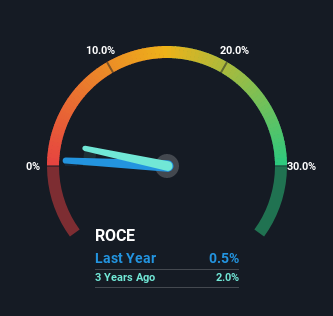- United States
- /
- Telecom Services and Carriers
- /
- NasdaqGS:LBTY.A
Some Investors May Be Worried About Liberty Global's (NASDAQ:LBTY.A) Returns On Capital

To avoid investing in a business that's in decline, there's a few financial metrics that can provide early indications of aging. Businesses in decline often have two underlying trends, firstly, a declining return on capital employed (ROCE) and a declining base of capital employed. This combination can tell you that not only is the company investing less, it's earning less on what it does invest. Having said that, after a brief look, Liberty Global (NASDAQ:LBTY.A) we aren't filled with optimism, but let's investigate further.
Understanding Return On Capital Employed (ROCE)
Just to clarify if you're unsure, ROCE is a metric for evaluating how much pre-tax income (in percentage terms) a company earns on the capital invested in its business. Analysts use this formula to calculate it for Liberty Global:
Return on Capital Employed = Earnings Before Interest and Tax (EBIT) ÷ (Total Assets - Current Liabilities)
0.0051 = US$200m ÷ (US$43b - US$3.9b) (Based on the trailing twelve months to December 2022).
Thus, Liberty Global has an ROCE of 0.5%. In absolute terms, that's a low return and it also under-performs the Telecom industry average of 6.5%.
Check out our latest analysis for Liberty Global

Above you can see how the current ROCE for Liberty Global compares to its prior returns on capital, but there's only so much you can tell from the past. If you're interested, you can view the analysts predictions in our free report on analyst forecasts for the company.
SWOT Analysis for Liberty Global
- Debt is well covered by cash flow.
- Earnings declined over the past year.
- Interest payments on debt are not well covered.
- Trading below our estimate of fair value by more than 20%.
- Annual earnings are forecast to decline for the next 3 years.
What The Trend Of ROCE Can Tell Us
We are a bit worried about the trend of returns on capital at Liberty Global. Unfortunately the returns on capital have diminished from the 1.8% that they were earning five years ago. On top of that, it's worth noting that the amount of capital employed within the business has remained relatively steady. Since returns are falling and the business has the same amount of assets employed, this can suggest it's a mature business that hasn't had much growth in the last five years. If these trends continue, we wouldn't expect Liberty Global to turn into a multi-bagger.
The Bottom Line
In summary, it's unfortunate that Liberty Global is generating lower returns from the same amount of capital. Investors haven't taken kindly to these developments, since the stock has declined 36% from where it was five years ago. With underlying trends that aren't great in these areas, we'd consider looking elsewhere.
On a final note, we found 4 warning signs for Liberty Global (2 don't sit too well with us) you should be aware of.
While Liberty Global isn't earning the highest return, check out this free list of companies that are earning high returns on equity with solid balance sheets.
New: AI Stock Screener & Alerts
Our new AI Stock Screener scans the market every day to uncover opportunities.
• Dividend Powerhouses (3%+ Yield)
• Undervalued Small Caps with Insider Buying
• High growth Tech and AI Companies
Or build your own from over 50 metrics.
Have feedback on this article? Concerned about the content? Get in touch with us directly. Alternatively, email editorial-team (at) simplywallst.com.
This article by Simply Wall St is general in nature. We provide commentary based on historical data and analyst forecasts only using an unbiased methodology and our articles are not intended to be financial advice. It does not constitute a recommendation to buy or sell any stock, and does not take account of your objectives, or your financial situation. We aim to bring you long-term focused analysis driven by fundamental data. Note that our analysis may not factor in the latest price-sensitive company announcements or qualitative material. Simply Wall St has no position in any stocks mentioned.
About NasdaqGS:LBTY.A
Liberty Global
Provides broadband internet, video, fixed-line telephony, and mobile communications services to residential and business customers.
Undervalued low.
Similar Companies
Market Insights
Community Narratives



